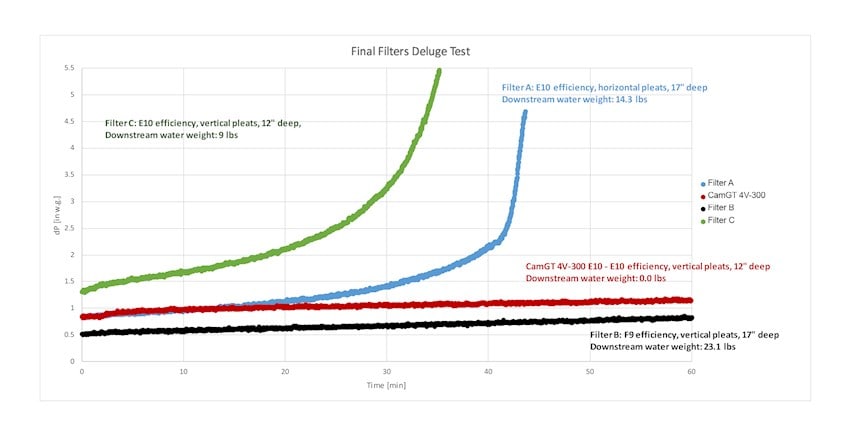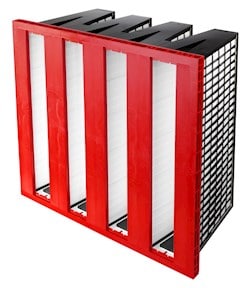AN ENERGY PLANT ON THE PACIFIC COAST UPGRADES TO THE CAMGT 4V-300 AIR INLET FILTERS AFTER TESTS SHOW ITS WATER AND SALT HANDLING CAPABILITIES.
In 2016, the engineering team for an energy plant located near the Los Angeles Airport in California conducted a boroscope inspection on two Siemens 501F gas turbine engines. The test showed signs of corrosion on both engines, partly resulting from their manufacturer standard F8 efficiency filters installed on-site. The team decided to evaluate the benefits of a higher efficiency final filter to reduce ambient salt on the turbine air inlet and the gas turbines.
The plant is located on the Pacific Coast in a deep hollow, where a thick marine layer (fog) draws in from the nearby ocean and settles in, causing increasingly high humidity conditions.
In environments where salt and other hydrophilic contaminants are present and humidity spikes are frequent, particles on the filter media can swell, causing high pressure drop (dP). High filter dP reduces compressor efficiency and ultimately power output. In an extreme case, it can set off a turbine alarm and force operators to derate. Furthermore, high dP increases the risk of salt migration through the filter media. In the presence of salt, the risk of hot-end corrosion increases, leading to costly turbine repairs.
Camfil‘s CamLab, a portable laboratory for testing filters, successfully completed a blind-test on site for a period of 2 122 hours in order to compare four filters from different manufacturers. All four filters have a 24"x24" face area but slightly different filter element depths.
During the test, the filters were exposed to on-site contaminants and atmospheric conditions. Corrosion coupons were also installed downstream of each filter duct to provide an additional reading into the performance of the air inlet filters.
After site testing was completed, the filters were sent to Camfil’s lab at the Montreal Test & Learn Center where the filters were retested in order to verify their performance in controlled laboratory conditions. Efficiency and pressure drop were first measured, followed by a deluge test (water spray).
Copper corrosion coupons were installed downstream of each filter duct to measure the level of air and water corrosivity. The coupons consist of high purity strips of copper, which were measured according to ISA 71.04:2013 for change in thickness resulting from corrosion of the base metals. Table 1 shows that the competitor filters had between 6900 and 7700 angstroms of corrosion. Meanwhile, the CamGT 4V-300 had 3300 angstroms of corrosion. That is twice the protection level to the nearest filter in the corrosion coupon test. This shows that filter efficiency is not enough to prevent corrosion - filters should be bypass-free, have vertical pleats, and good drainage capabilities to reduce corrosion risks.
Final filter efficiency is summarized in Table 1. Three of the four filters achieved an E10 rating according to EN1822:2009, whereas Filter B achieved an F9 rating per EN779:2012.
Table 3 summarizes pressure drop results. Filter C had the highest dP at the end of the test, while Filter B had the lowest. The low pressure of Filter B can be explained by the relatively low efficiency, as it is the only F9 filter compared to the three higher rated E10 filters.
The CamGT 4V-300 12" filter had an identical pressure to Filter A 17". This shows that overall length of the filter alone does not imply a lower dP.
| Filter | Total Å |
|---|---|
| Filter A (E10) 17" | 7749.7 |
| Filter B (F9) 17" | 7303.2 |
| Filter C (E10) 12" | 6947.3 |
| CamGT 4V-300 (E10) 12" | 3386.7 |
| Filter | Efficiency (EN1822:2009) |
|---|---|
| Filter A (E10) 17" | E10 |
| Filter B (F9) 17" | F9* |
| Filter C (E10) 12" | E10 |
| CamGT 4V-300 (E10) 12" | E10 |
*According to EN779:2012
| Filter | Pressure Drop (inch w.g.) |
|---|---|
| Filter A (E10) 17" | 1.02 |
| Filter B (F9) 17" | 0.66 |
| Filter C (E10) 2" | 1.51 |
| CamGT 4V-300 E10 12" | 1.01 |
After the completion of all efficiency and dP analysis, a deluge test was performed on the dust-loaded filters from the CamLab test to verify the performance of the final filters when exposed to water spray.
The test determines:
4" w.g. or one hour had passed, whichever occurred first. Results in Figure 1 show that each filter had more than 20% water bypass with the exception of the Camfil filter. Further, the CamGT was the only filter that lasted the full 60 minutes, without any substantial amount of water bypass, and ending at a low dP. The results show that the CamGT would perform well in high humidity, fog conditions.

| Filter | Test Duration (min) | Water Sprayed (lbs) | Water Bypass | Max. dP During Test (inch wg) |
|---|---|---|---|---|
| Filter A | 43 | 47 | 14 | 4.7 |
| Filter B | 60 | 66 | 23 | 0.8 |
| Filter C | 35 | 39 | 9 | 5.5 |
| CamGT 4V-300 | 60 | 66 | 0 | 1.2 |
Satisfied with the results of the tests, the plant upgraded their filtration system to the CamGT 4V-300, E10 filters for both engines.
 CamGT 4V-300
CamGT 4V-300The CamGT 4V-300 was the only filter to successfully pass all four tests. It showed measurable improvements in corrosion as compared to the other filters in the corrosion coupon test. All filters were equivalent in initial efficiency, however, as the efficiency test on used filters, the corrosion test, as well as the deluge test demonstrate, initial lab test efficiency should not be the only factor to consider. Filters should also be hydrophobic to prevent water and salt penetration.
CamGT’s supreme performance is based on Camfil’s unique design features that enable stable performance during extreme weather conditions.